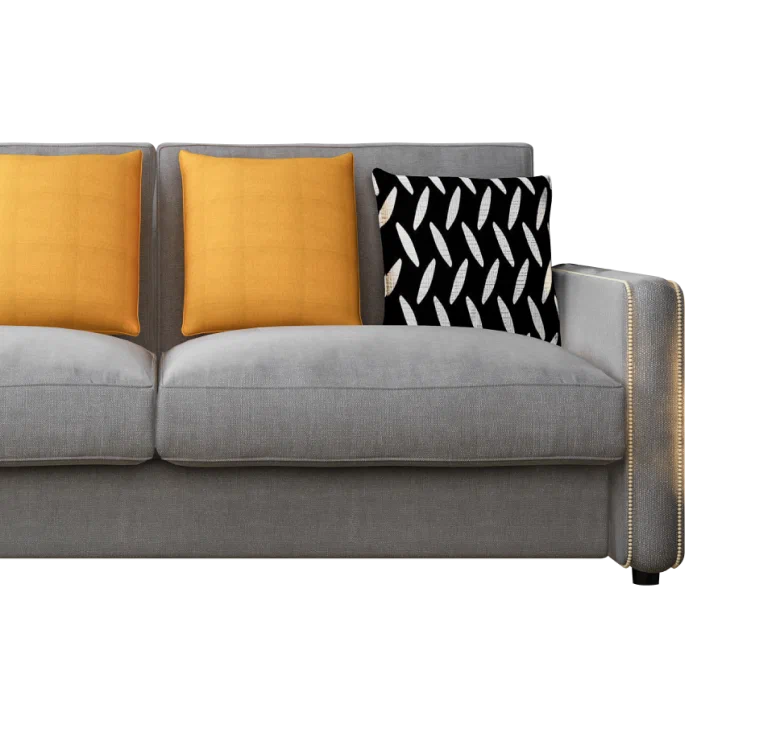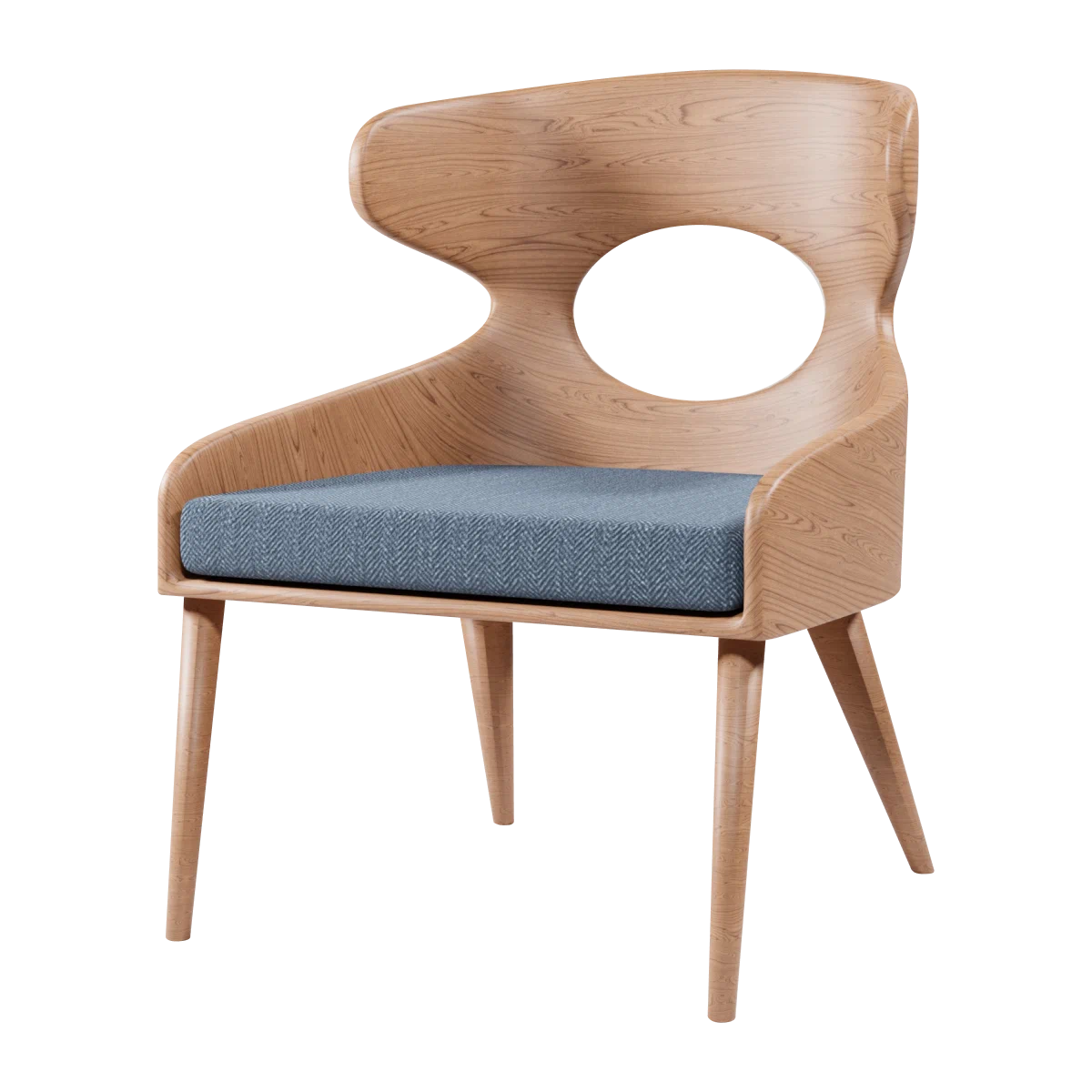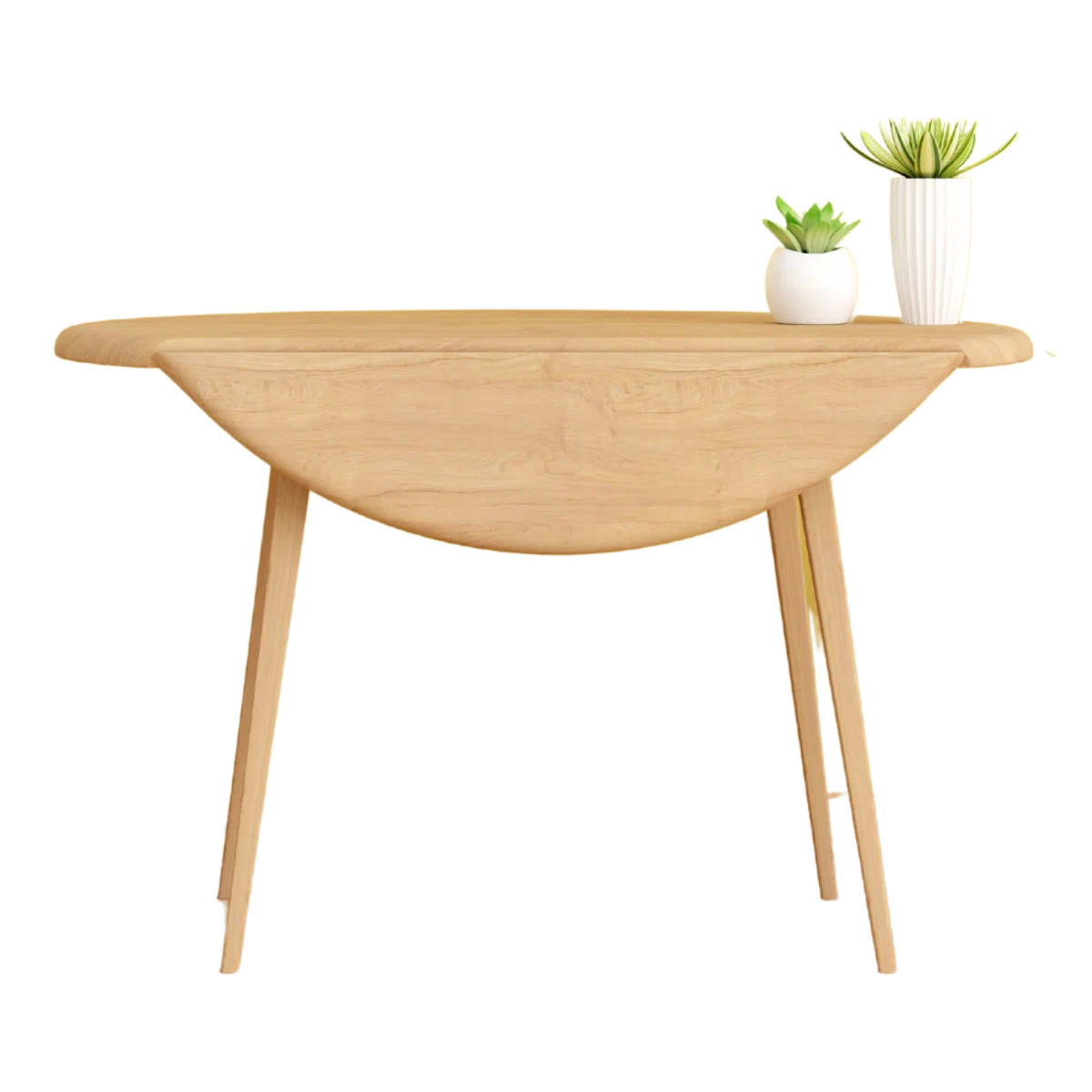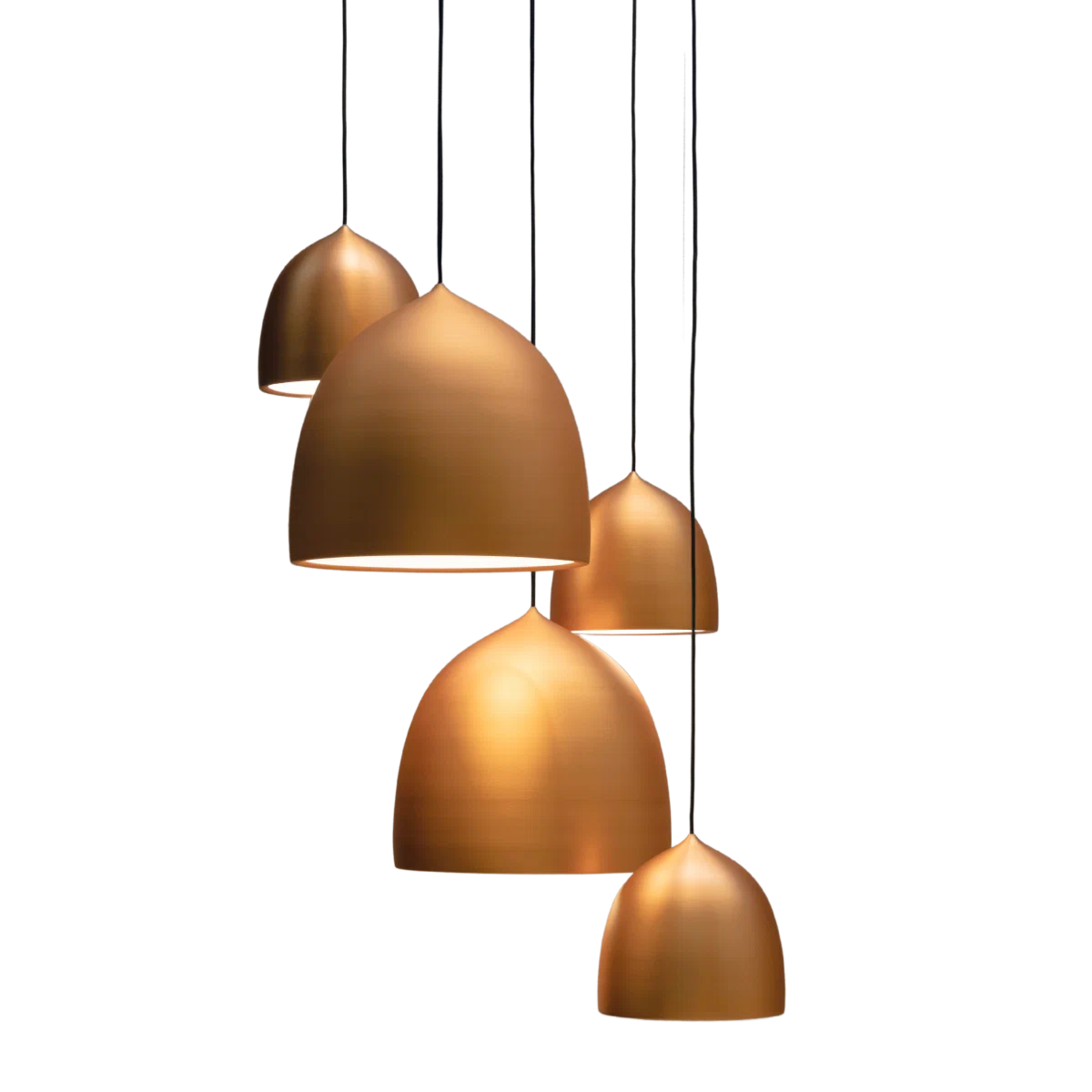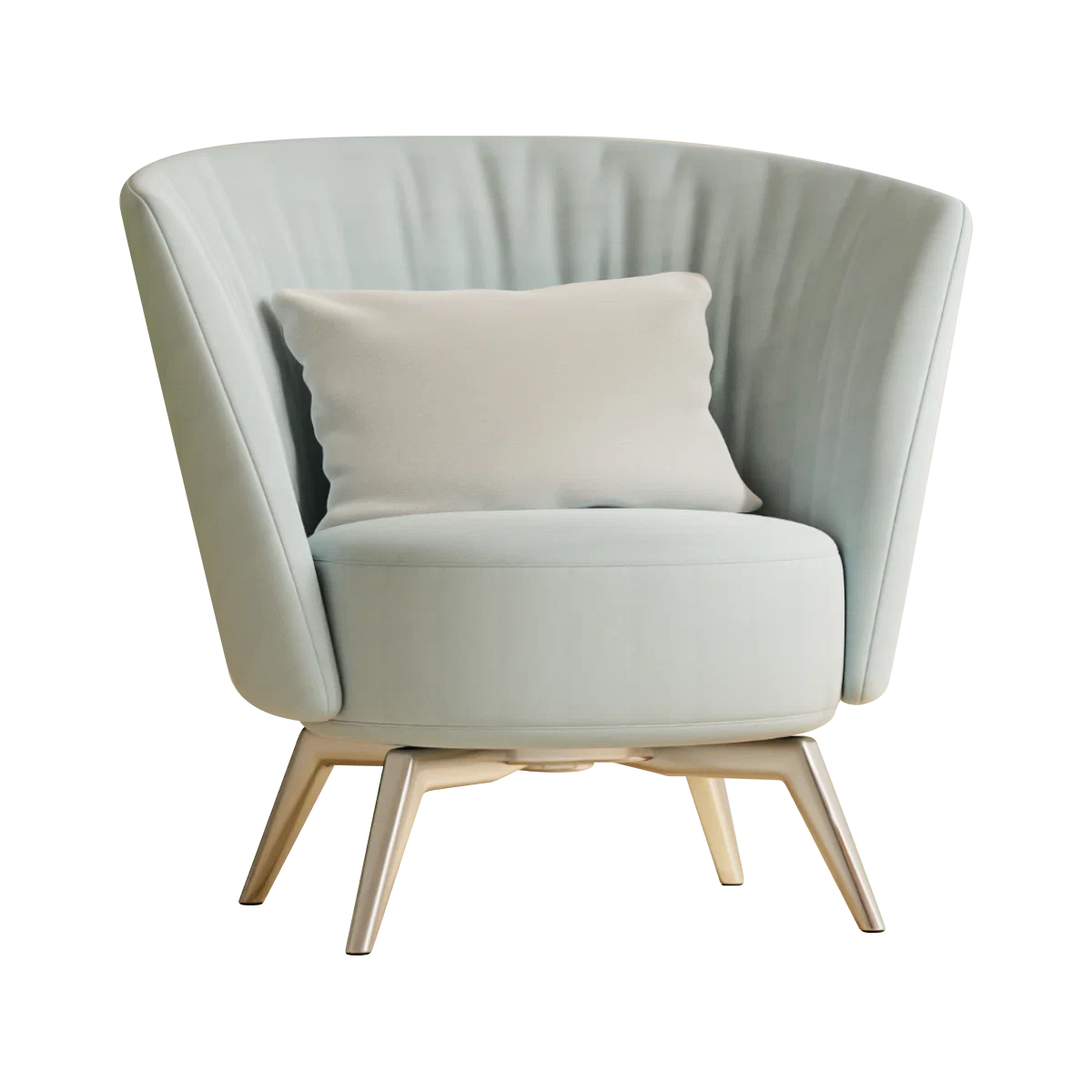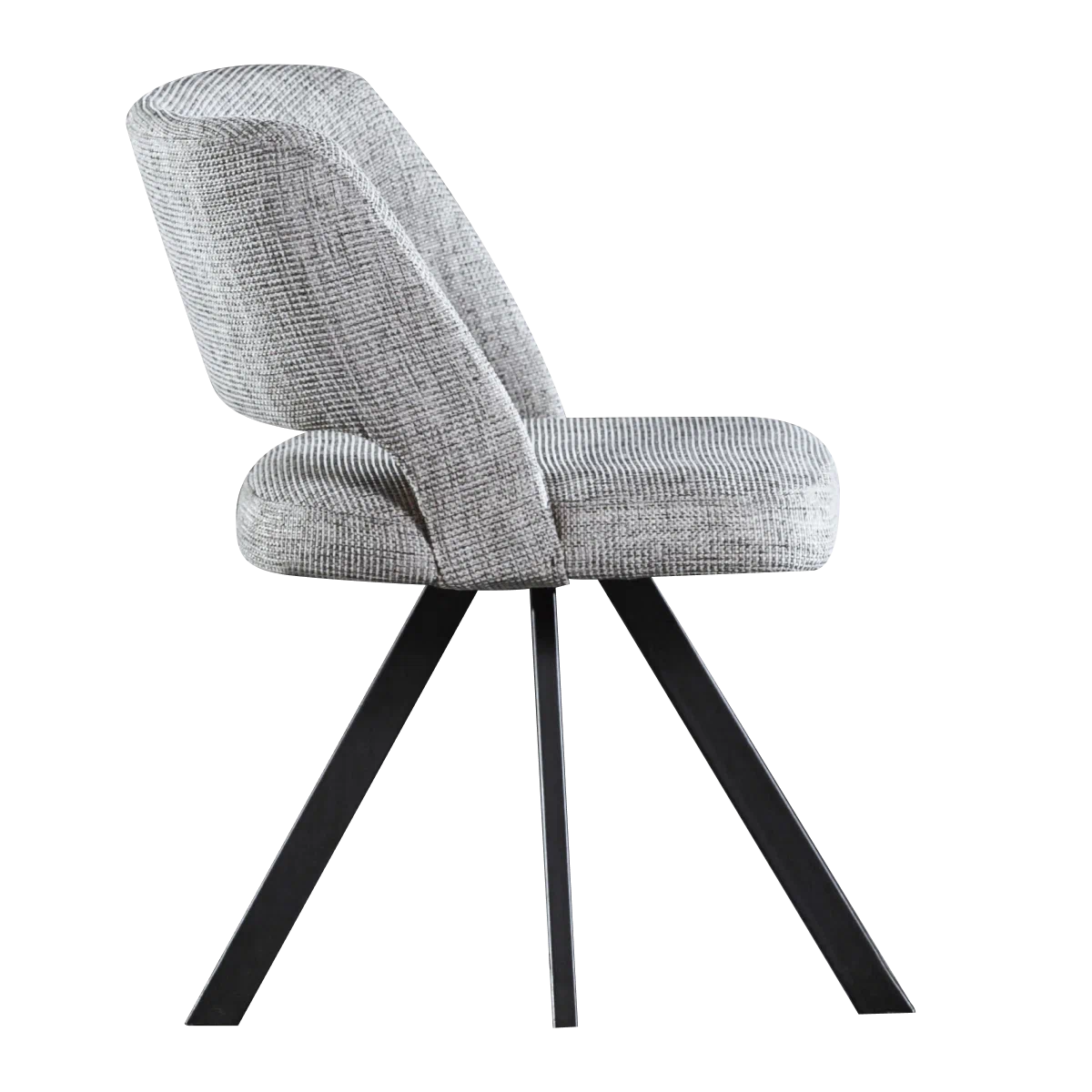
Will My Sofa Fit Calculator: How to measure sofa to fit through door
February 23, 2025
Will My Sofa Fit Calculator: How to measure sofa to fit through door
February 23, 2025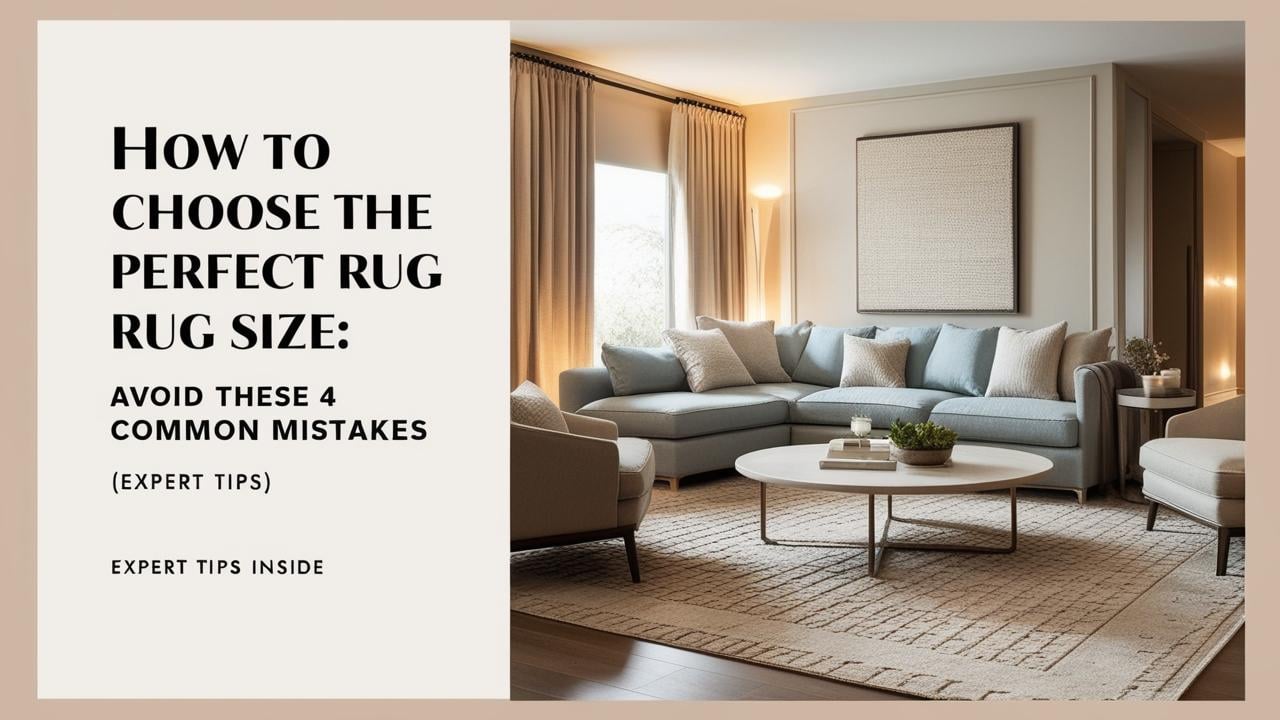
How to Choose the Perfect Rug Size: Avoid These 4 Common Mistakes (Expert Tips)
Unlock your room's potential: the secret is often in the rug size! Picking a rug seems simple, but choosing the wrong size is one of the most impactful and common decorating mistakes, instantly making a room feel awkward, incomplete, or poorly planned. A well-chosen rug doesn't just cover the floor; it's a powerful design tool that ties your space together, defines functional zones, and adds essential warmth and texture. Get the size wrong, however, and you risk a space that feels disjointed, smaller than it is, or simply "off" – potentially undermining all your other decorating efforts.
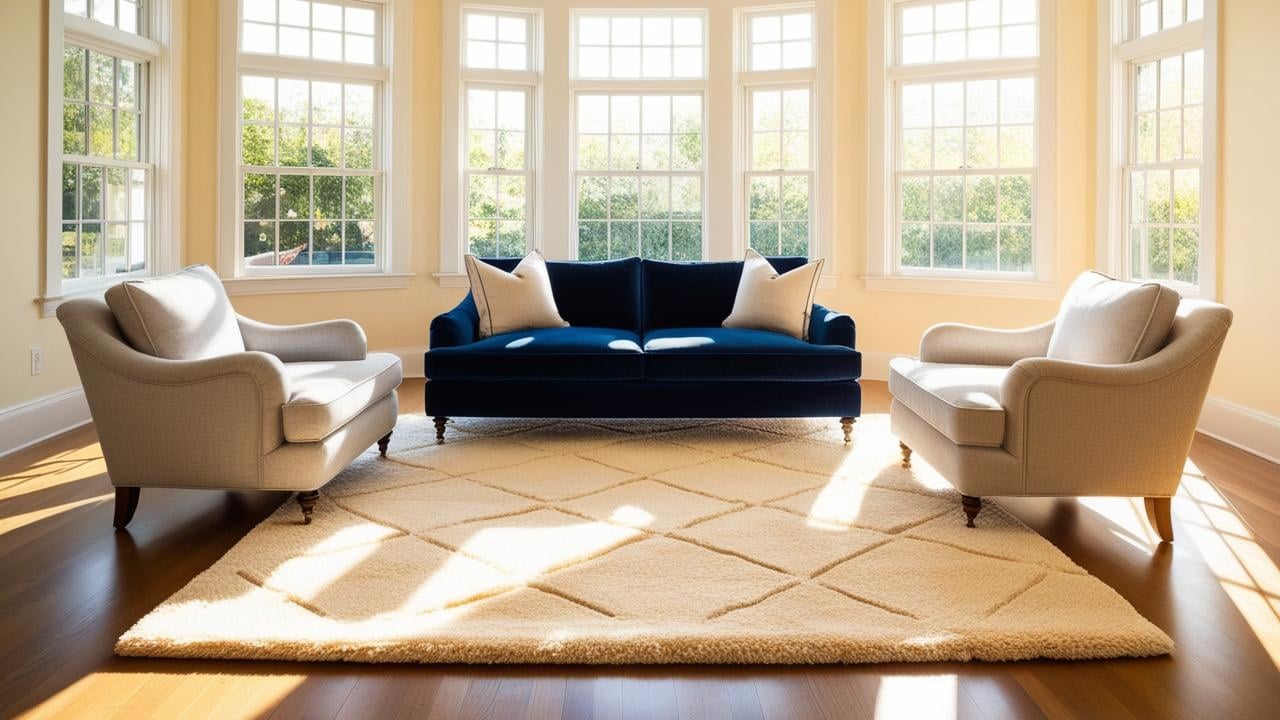
Feeling anxious about choosing the right rug size? You're not alone. Many homeowners find themselves paralyzed by standard dimensions, conflicting advice, and the fear of making costly errors, especially given that rugs can be a significant investment.
This expert rug size guide cuts through the confusion. We'll break down essential rug placement tips, highlight common rug size mistakes (and how to avoid them!), and give you the confidence to finally select the perfect foundation that transforms your room.
Why Rug Size Matters More Than You Think
A well-sized rug is more than decorative; it's foundational to good room design:
- Defines Functional Zones: Especially in open-plan homes or large rooms, rugs create clear visual boundaries for distinct areas like seating groups, dining spaces, or reading nooks, bringing order and purpose.
- Creates Cohesion & Anchors Furniture: A rug of the right scale prevents furniture from looking like it's "floating" aimlessly. It visually connects pieces, creating a cohesive, grounded, and intentional arrangement.
- Impacts Perceived Room Size: Counterintuitively, an appropriately large rug can make a room feel bigger and more unified. A small rug, by contrast, can make a space feel choppy and smaller.
- Adds Comfort, Style & Warmth: Rugs introduce vital color, pattern, texture, and warmth, significantly impacting a room's ambiance and comfort underfoot. They can also improve acoustics by absorbing sound.
The Single Biggest Rug Mistake: Going Too Small!
Before we dive into specifics, let's address the most common pitfall: choosing a rug that is too small. This is the number one regret homeowners express.
Why it Looks Wrong:
The Impact:
The Golden Rule:
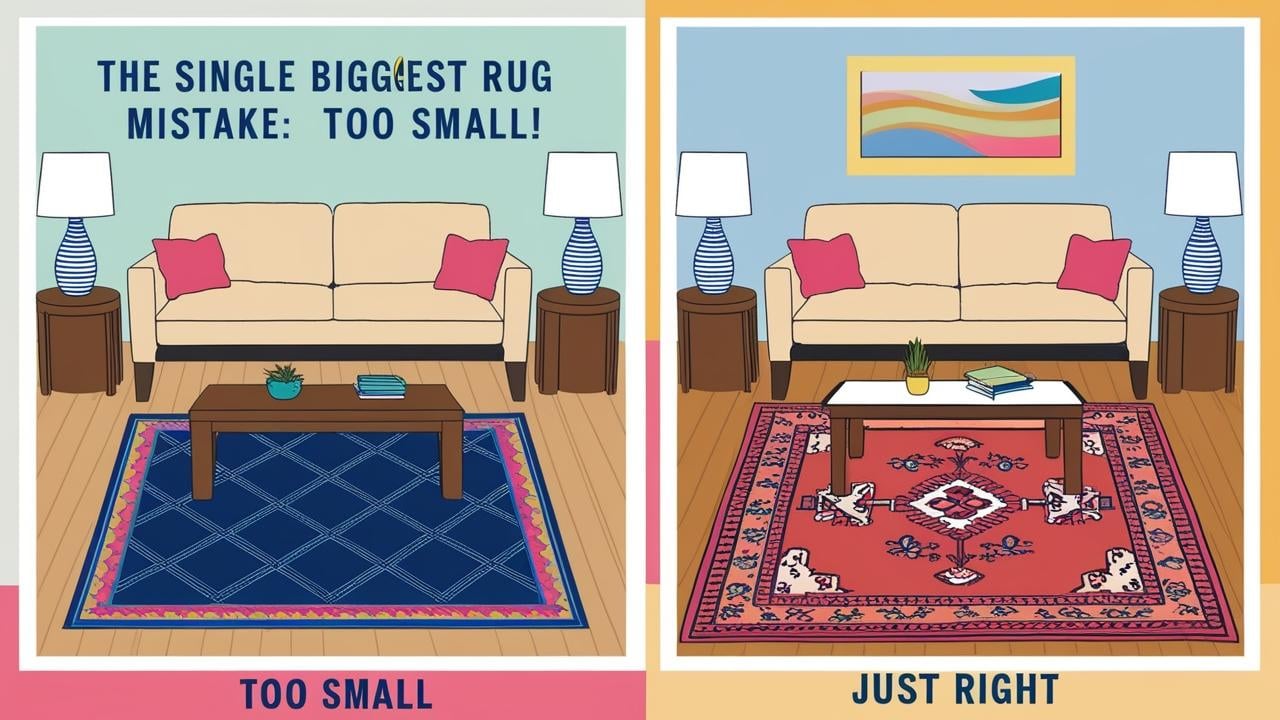
The Golden Rules: Essential Rug Sizing Principles
Master these core concepts for how to pick a rug size and make confident decisions.
1. Anchor Your Furniture: The Legs On/Off Debate
The primary goal is to use the rug to visually connect your main furniture pieces. How the furniture legs interact with the rug is key:
All Legs On:
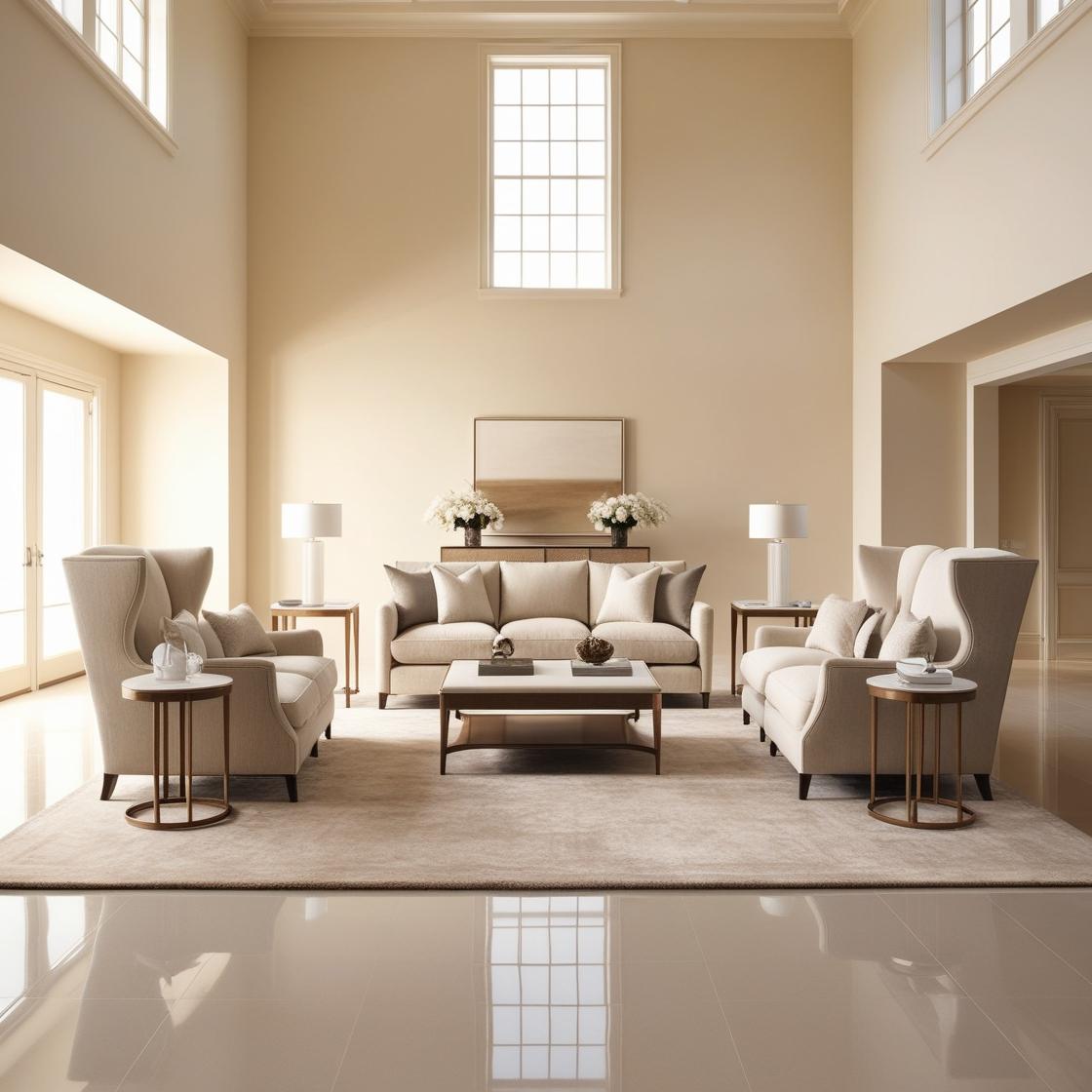
- Pros: Creates the most unified, luxurious, and grounded appearance. Excellent for defining zones in large or open-plan spaces.
- Cons: Requires a very large rug (e.g., 9x12, 10x14+), which is more expensive and may not fit all rooms.
- Best For: Spacious living rooms where the entire seating arrangement can comfortably fit on the rug with room to spare.
Front Legs On (Most Common):
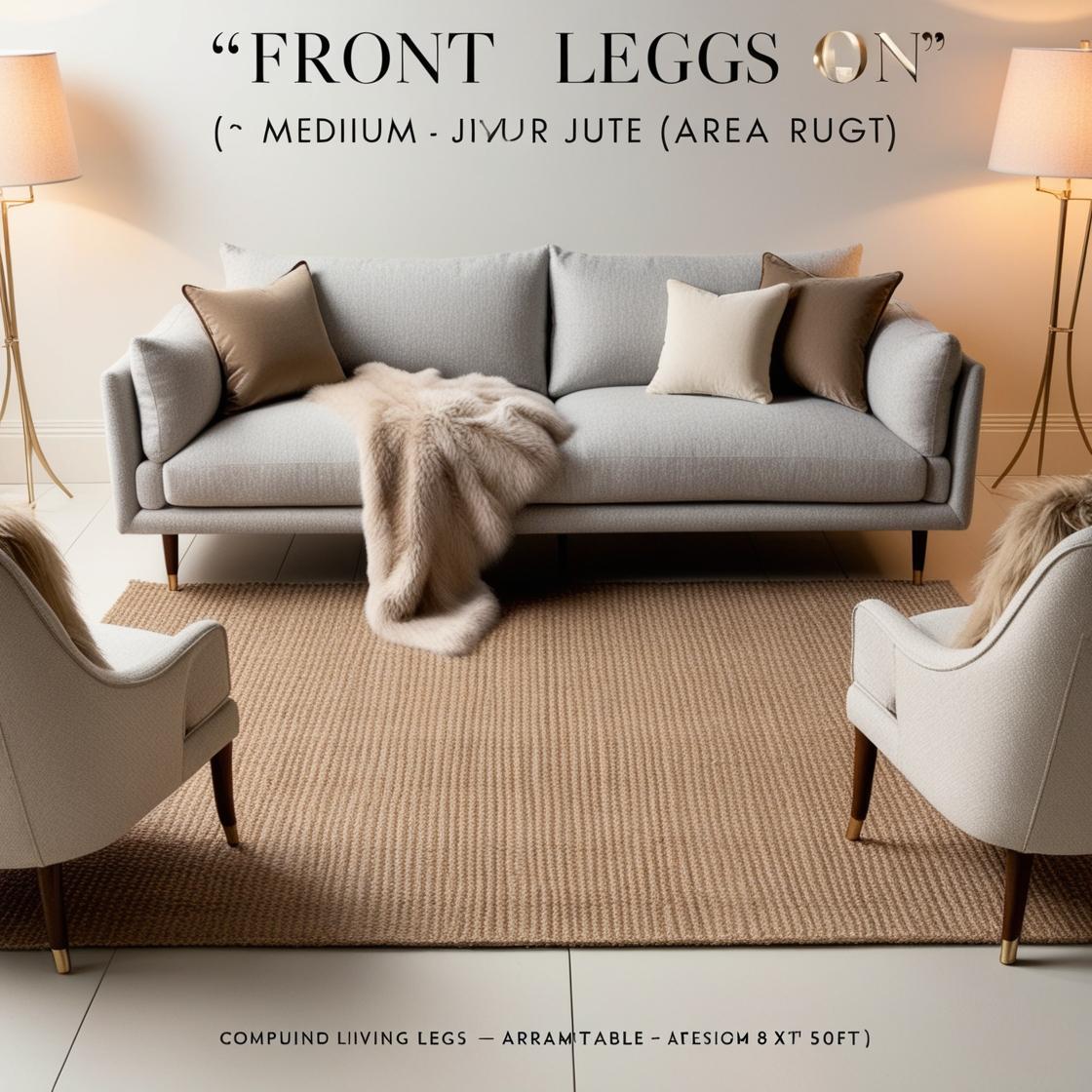
- Pros: This is the most popular and often most practical guideline. Placing just the front legs of sofas and chairs onto the rug effectively anchors the pieces and connects the conversation area without needing the largest possible rug. It's a great balance of aesthetics and cost.
- Cons: Requires careful measurement to ensure the rug is deep enough.
- Best For: Most average-sized living rooms. This is often the best rug size for living room balance.
All Legs Off (Use Sparingly):
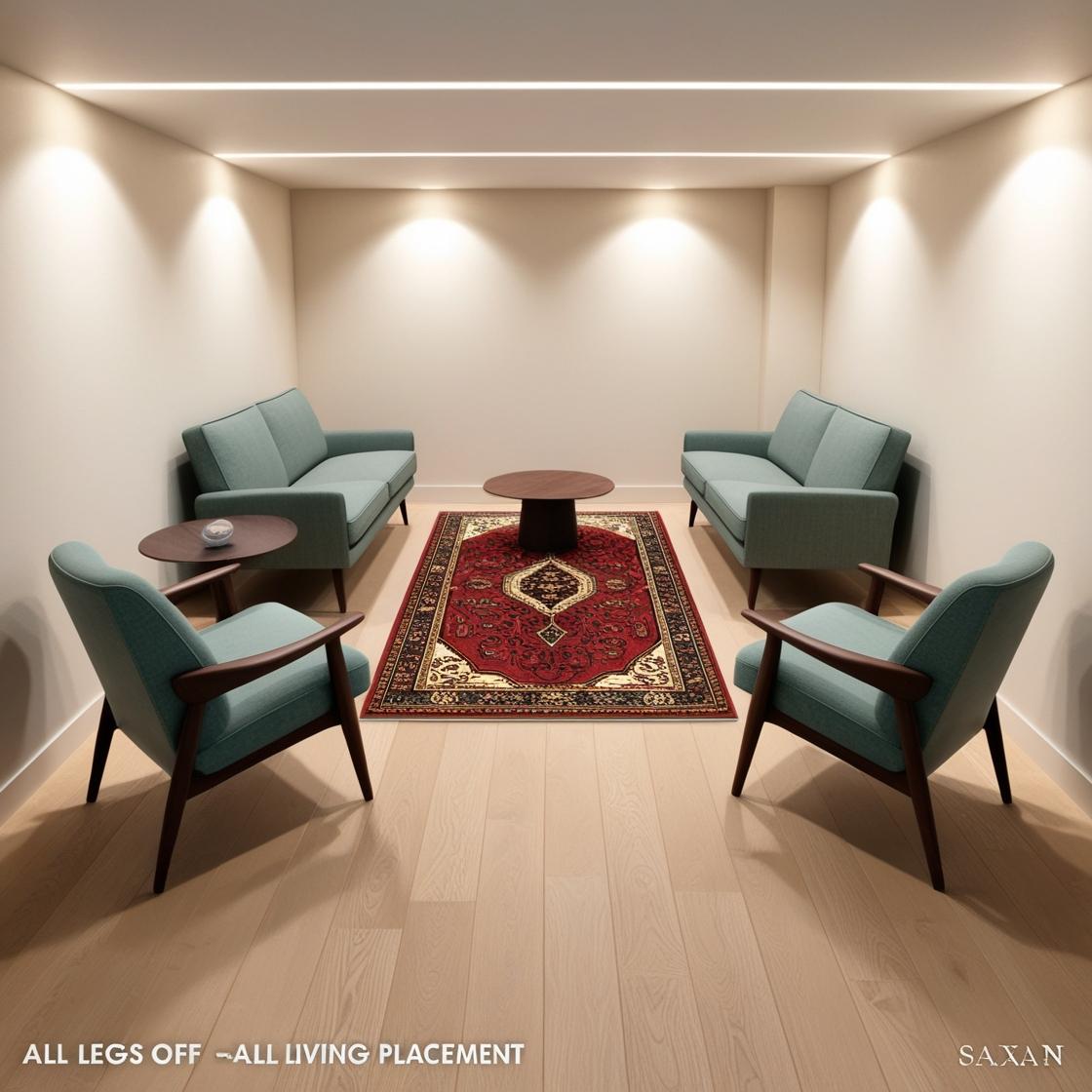
- Pros: Can work for very small accent rugs or in extremely tight spaces where any other option is impossible.
- Cons: Generally discouraged for primary seating areas as it makes the rug look undersized, like an afterthought, and fails to unify the furniture. The furniture can appear to be "floating."
- Best For: Occasionally under a coffee table if the rug is clearly an accent layer on a larger rug, or in very compact rooms as a last resort.
Consistency is Key:

2. Mind the Gap: Borders and Proportions
Your rug needs some "breathing room." It shouldn't look like ill-fitting wall-to-wall carpet, which can make a room feel smaller.
The Border Rule:
Smaller Rooms:
Sofa Width:

3. How to Measure Accurately & Visualize Before You Buy
Guesswork leads to regrets! Accurate measurements are non-negotiable.
Measure the Room:
Measure Your Furniture/Seating Area:
Visualize with Painter's Tape (Crucial!):
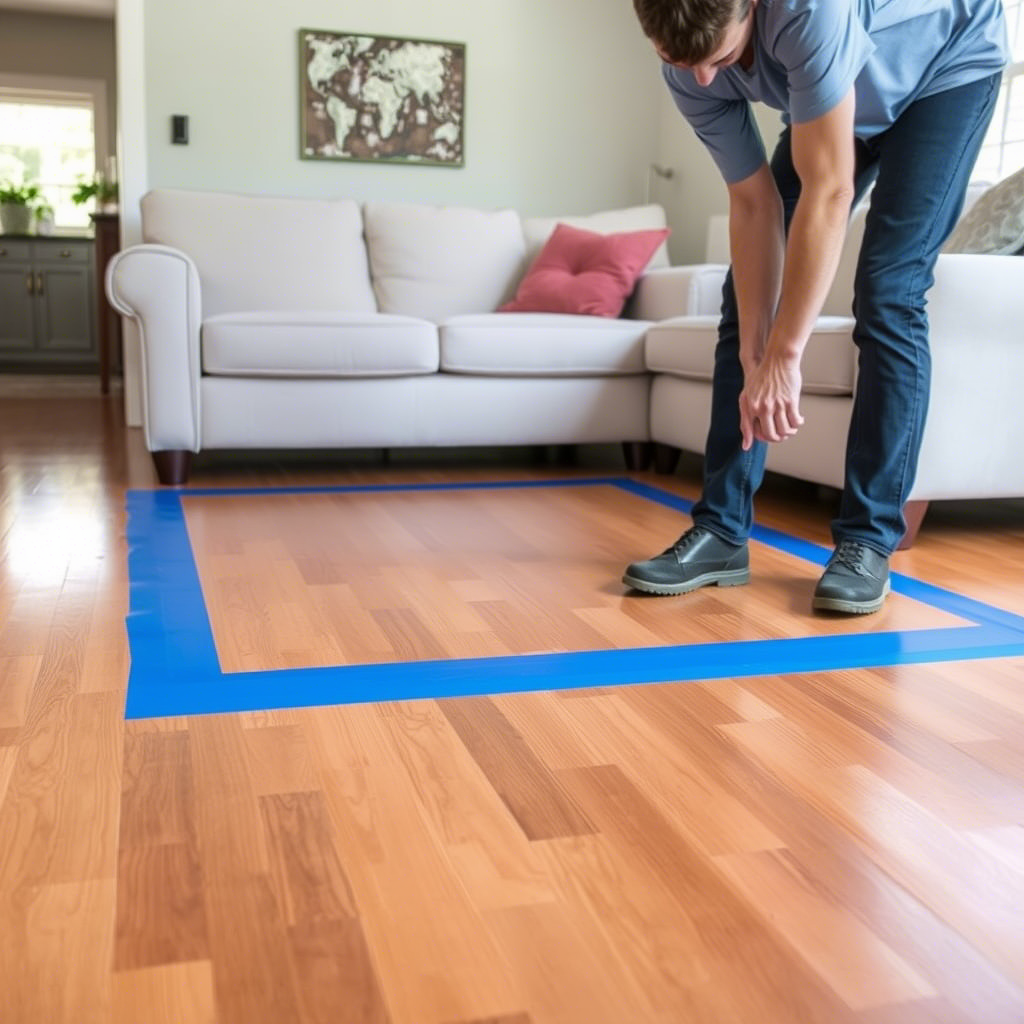
4. Consider Orientation
How you orient a rectangular rug can also impact the room's feel.
Align with Room Shape:
Align with Main Seating:
Rotation as a Solution:
Quick Reference: Common Rug Sizes & Uses
| Rug Size | Typical Use Case | Key Considerations |
|---|---|---|
| 3'x5' | Entryway accent, beside bed (Twin/Full), layered rug top, small kitchen area | Often too small for main living/dining areas unless layered. |
| 5'x7' / 5'x8' | Small living rooms (coffee table only or front legs of small sofa/loveseat), under Twin/Full bed | Can look undersized in average living rooms; may work for 4-seat dining table in tight space. |
| 6'x9' | Small-to-medium living rooms (front legs on standard sofa), under Full/Queen bed, 4-6 seat dining table | Versatile size, often a good compromise. |
| 8'x10' | Standard living rooms (front legs on sofa + chairs), under Queen/King bed, 6-seat dining table | Most common living room size; ensures dining chairs stay on rug. |
| 9'x12' | Larger living rooms (all legs on or front legs on sectional), under King bed, 8+ seat dining table | Ideal for sectionals and larger dining sets. |
| 10'x14' + | Very large living rooms/open concept, under King bed + nightstands, large dining tables | Creates defined zones in open spaces; ensures ample dining chair room. |
| Runners | Hallways, beside beds, kitchens | Length varies; width typically 2.5'-3'. |
How to Choose a Rug Size Checklist
Want the quick version? Here’s how to pick a rug size:
Measure Your Room:
Measure Your Furniture:
Choose Placement:
Factor in Borders:
Check Sofa Width:
Visualize:
Consider Room Use:
When in Doubt, Go Bigger:
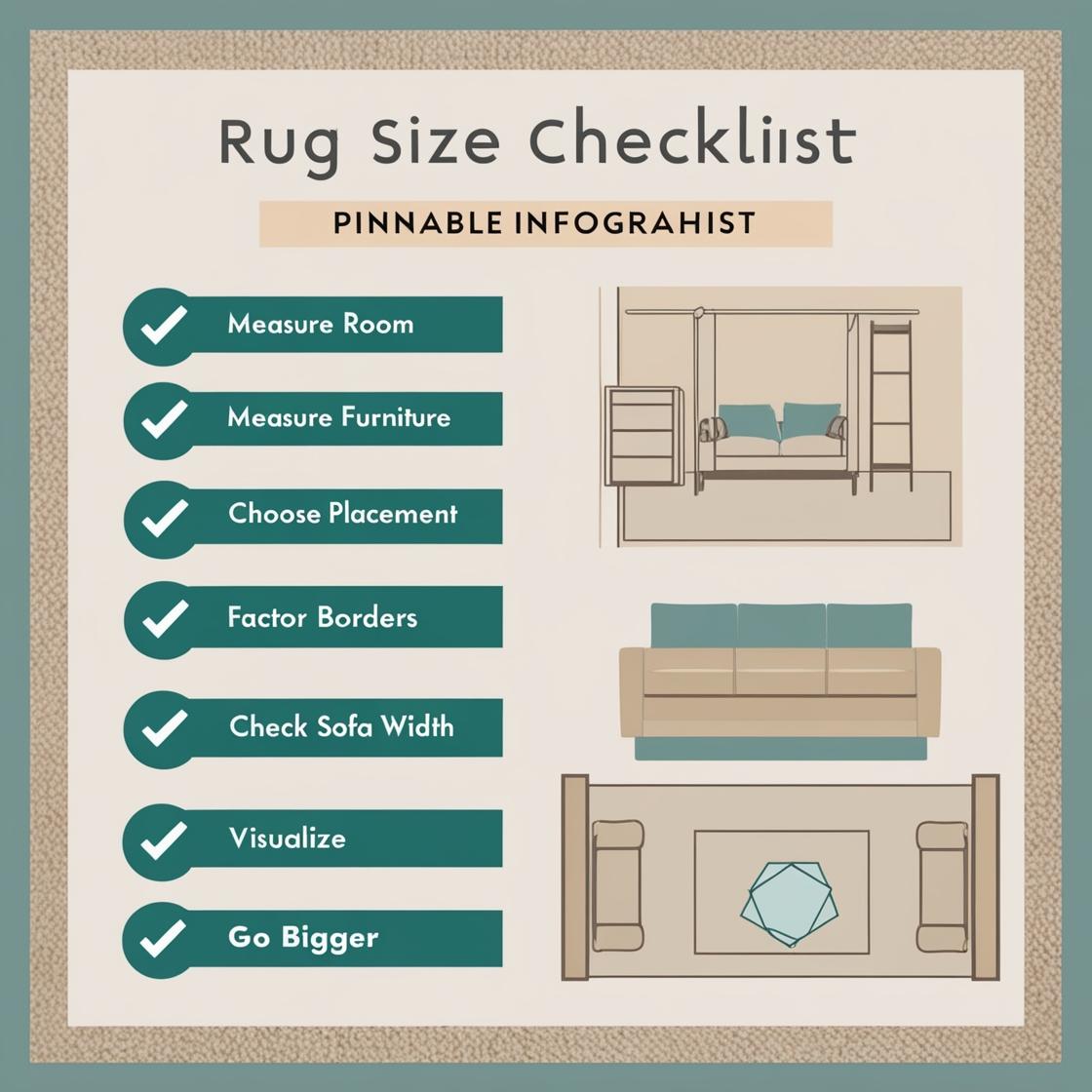
Room-by-Room Deep Dive: Applying the Principles
With these foundational principles in mind, let's explore how they apply to the unique needs of different rooms.
Living Room Rugs: Anchoring Your Conversation Zone
This is where choosing the right rug size is often most critical, as it sets the stage for your main gathering area.
Standard Setups (Sofa + Chairs):
- Best Sizes: 8'x10' or 9'x12' are the most common and versatile choices for average living rooms. An 8x10 usually works perfectly with the "front legs on" rule for a standard sofa and two chairs. A 9x12 provides more generous coverage, potentially fitting all furniture legs, especially in slightly larger spaces.
- Avoid: A 5x7 rug floating only under the coffee table often looks disproportionately small and fails to connect the seating.
- Mini Case Study: For a living room with a standard 84-inch sofa and two armchairs, an 8x10 rug allows the front legs of all pieces to rest on the rug, creating a defined conversation area while leaving walkways clear.
Layout Pros & Cons:
- 'Front legs on' is often best for balancing visual connection with maintaining some exposed flooring, making the room feel open.
- 'All legs on' provides maximum unity but can feel too dominant if the rug is oversized for the room.
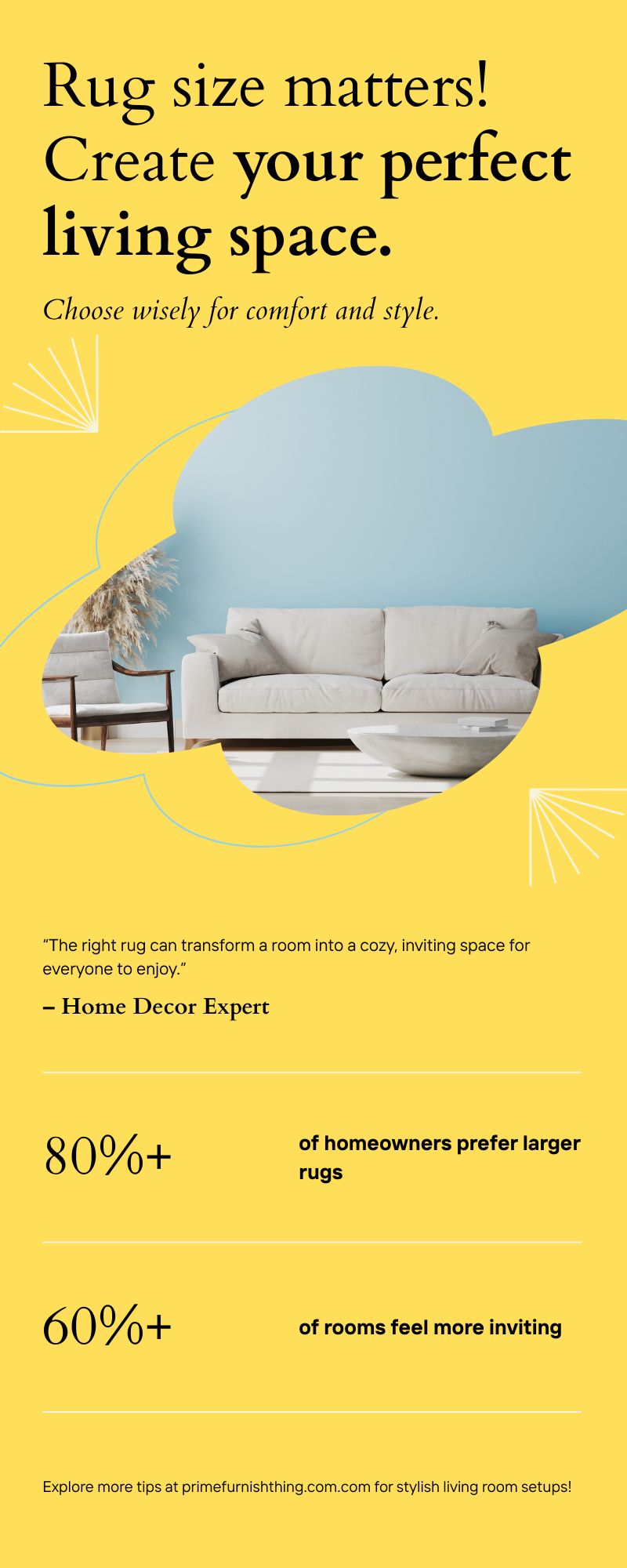
Sectionals:
These large pieces demand larger rugs to look balanced.
-
- Go Big! This is the near-universal advice from homeowners and designers. A small rug looks particularly awkward and out of scale with a bulky sectional.
- Placement: Aim for at least the front legs of all sectional pieces on the rug. Ideally, the entire sectional fits comfortably on the rug with a few inches of rug visible around it.
- Common Sizes: 9'x12' or 10'x14' are often the minimum sizes needed to properly anchor a sectional.
- Mini Case Study: For an L-shaped sectional measuring 10ft x 8ft, a 10x14 rug would allow the entire sectional to sit on the rug, clearly defining the seating zone in an open-concept space.
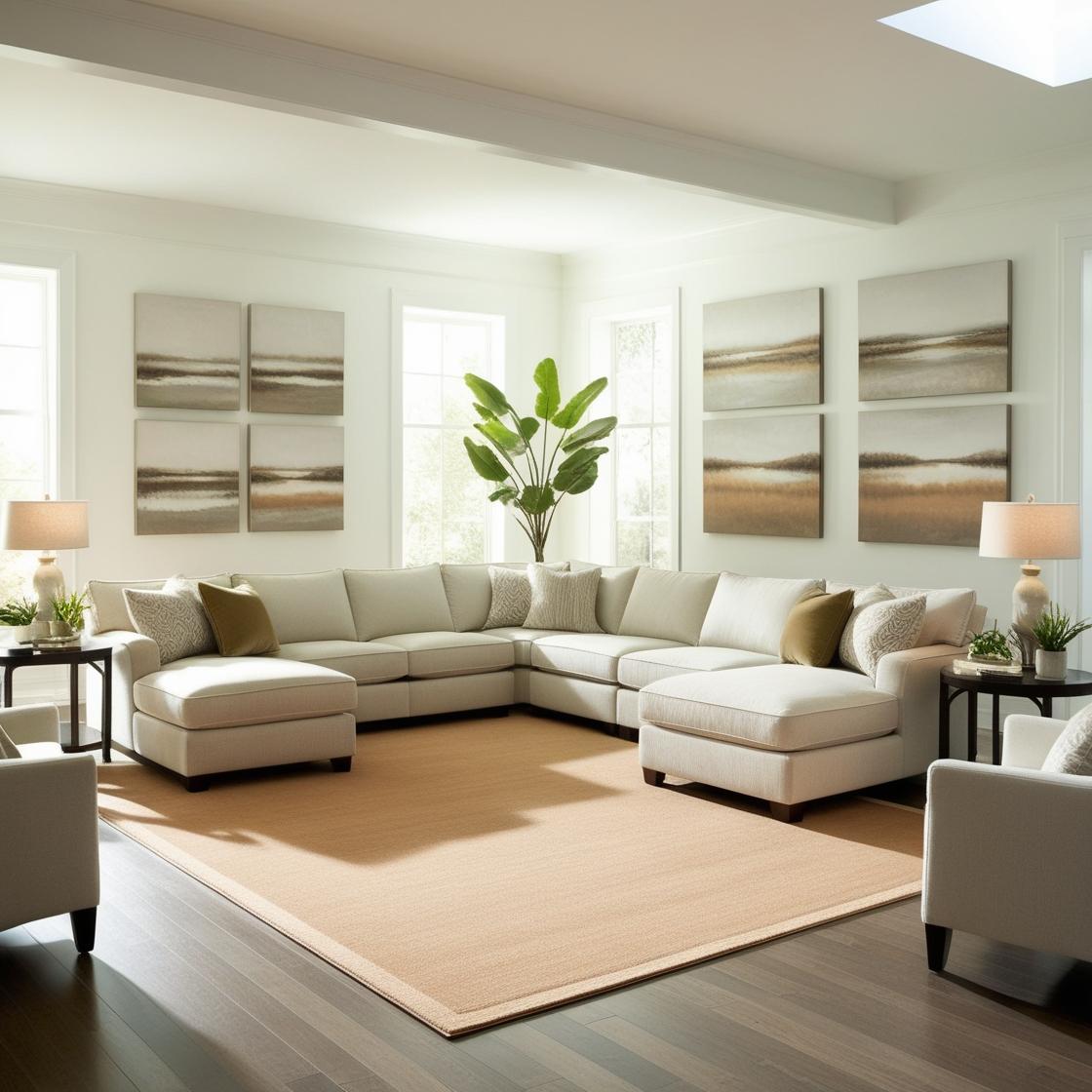
Small Living Rooms/Apartments:
Large rugs can overwhelm compact spaces.
-
- Best Sizes: 5'x7' or 6'x9' are generally more appropriate.
-
- Placement: Try for the "front legs on" approach with a 6x9 if possible. A 5x7 might only fit under the coffee table, creating that less desirable "floating" look.
- Layering Trick: A fantastic solution for small spaces or budget constraints! Place a larger, inexpensive neutral rug (like jute or sisal) sized correctly for the seating area. Then, layer your smaller, more decorative (or expensive) rug on top. This achieves the right scale visually and adds texture. (Internal Link Suggestion: Link to a post about rug layering techniques)
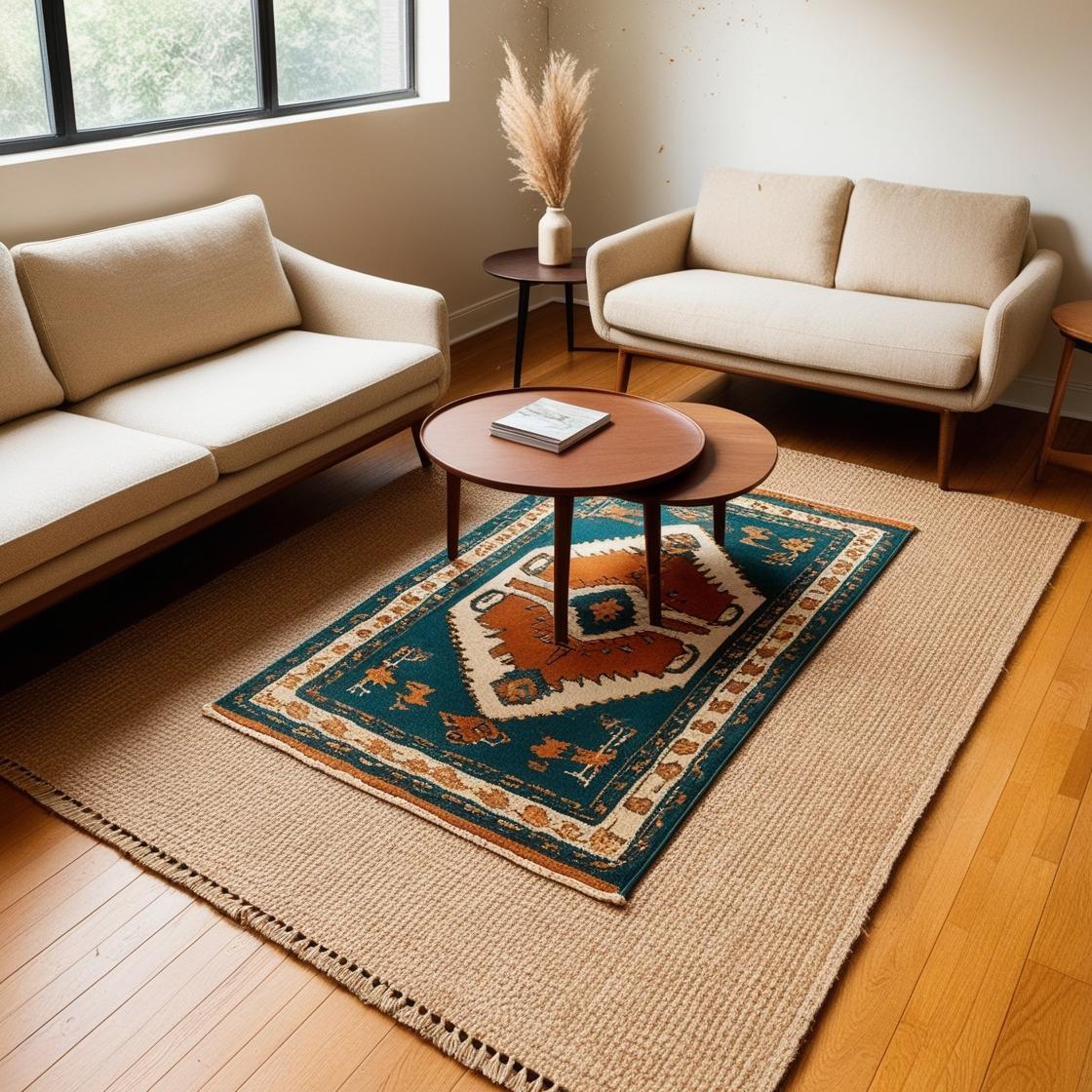
Dining Room Rugs: The Chair Test is Crucial
Function dictates the size here. There's one non-negotiable guideline for dining rooms.
The Cardinal Rule:
How to Measure:
Why it Matters:
Common Sizes:
Table Shape & Rug Shape:
Practicality:
Mini Case Study:
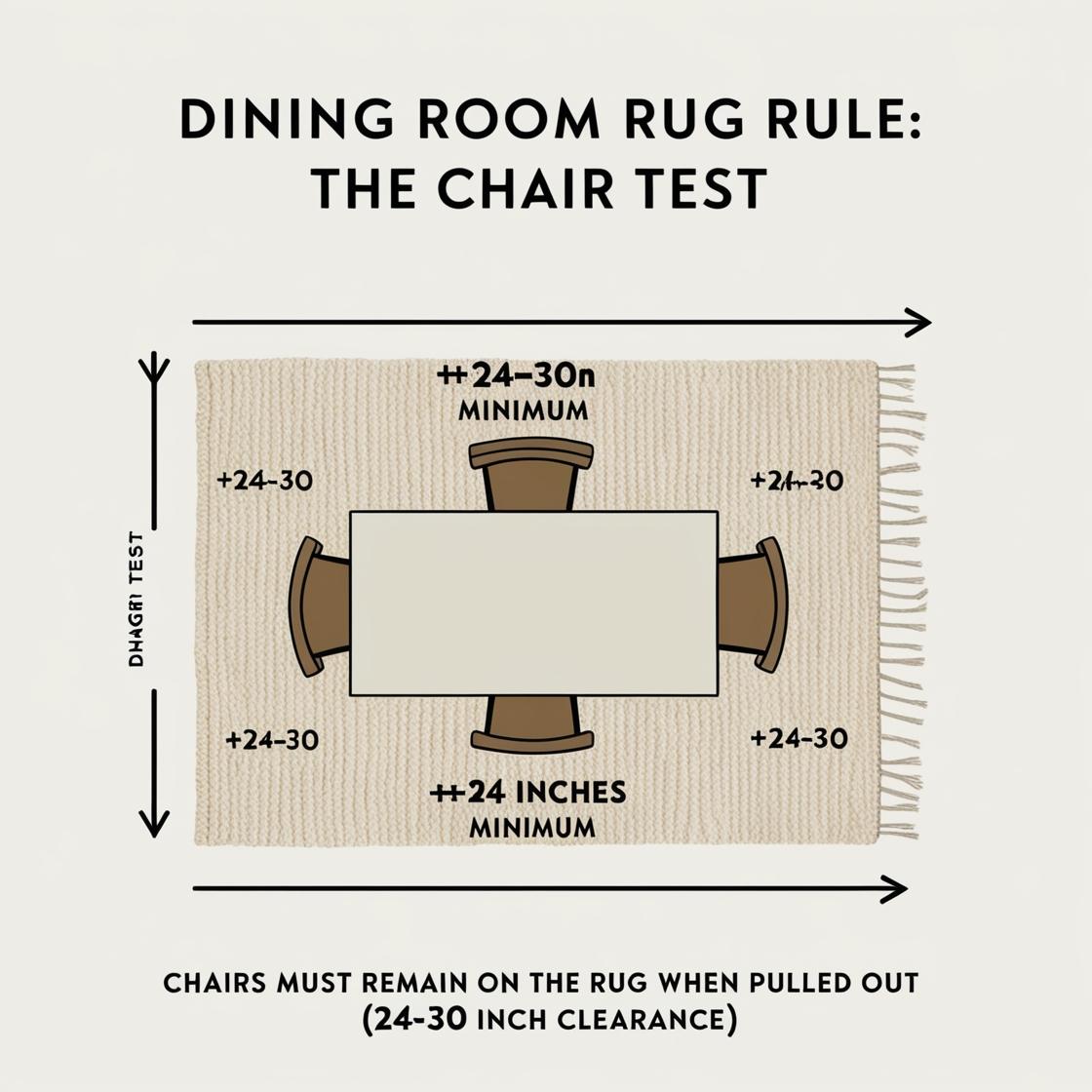
Bedroom Rugs: Soft Landings & Defined Zones
In the bedroom, rugs add comfort underfoot, define the sleeping zone, and visually anchor the bed.
The Goal:
Partial Coverage (Most Common):
Sizing by Bed:
- Twin: 5'x8' or 6'x9'. Runners or small 3x5 rugs beside the bed are alternatives.
- Full: 6'x9' or 8'x10'.
- Queen: 8'x10' is the standard recommendation, providing good coverage. A 6'x9' can work in smaller rooms.
- King: 9'x12' is typically needed for adequate coverage. A 10'x14' works in very large rooms. Runners are common alternatives.
Placement Options & Nightstands:
General Rule:
Full Coverage:
Runners:
Mini Case Study:

Hallway & Entryway Rugs (Runners)
Define Path & Add Warmth:
Width:
Length:
Durability:
Small Living Rooms/Apartments:
Function rules here. There's one non-negotiable guideline.
- The Cardinal Rule: All four legs of the dining chairs MUST remain on the rug, even when pulled out for seating.
- How to Measure: Measure your table, then add at least 24 inches (2 feet) of rug clearance on all sides. 30-36 inches is even better. Pull a chair out and measure!
- Why it Matters: Chairs catching on the edge are annoying and can damage floors.
- Common Sizes: 4-seat table often needs 6'x9' or 8' Round ; 6-seat table usually needs 8'x10' ; 8+ seats typically require 9'x12' or 10'x14'.
- Table Shape: Rectangular rugs work under round tables, and vice versa. Size for the table when fully extended if it has leaves.
- Practicality: Choose durable, easy-to-clean materials and low-pile or flat-weave rugs for easy chair movement.
Layering Trick:
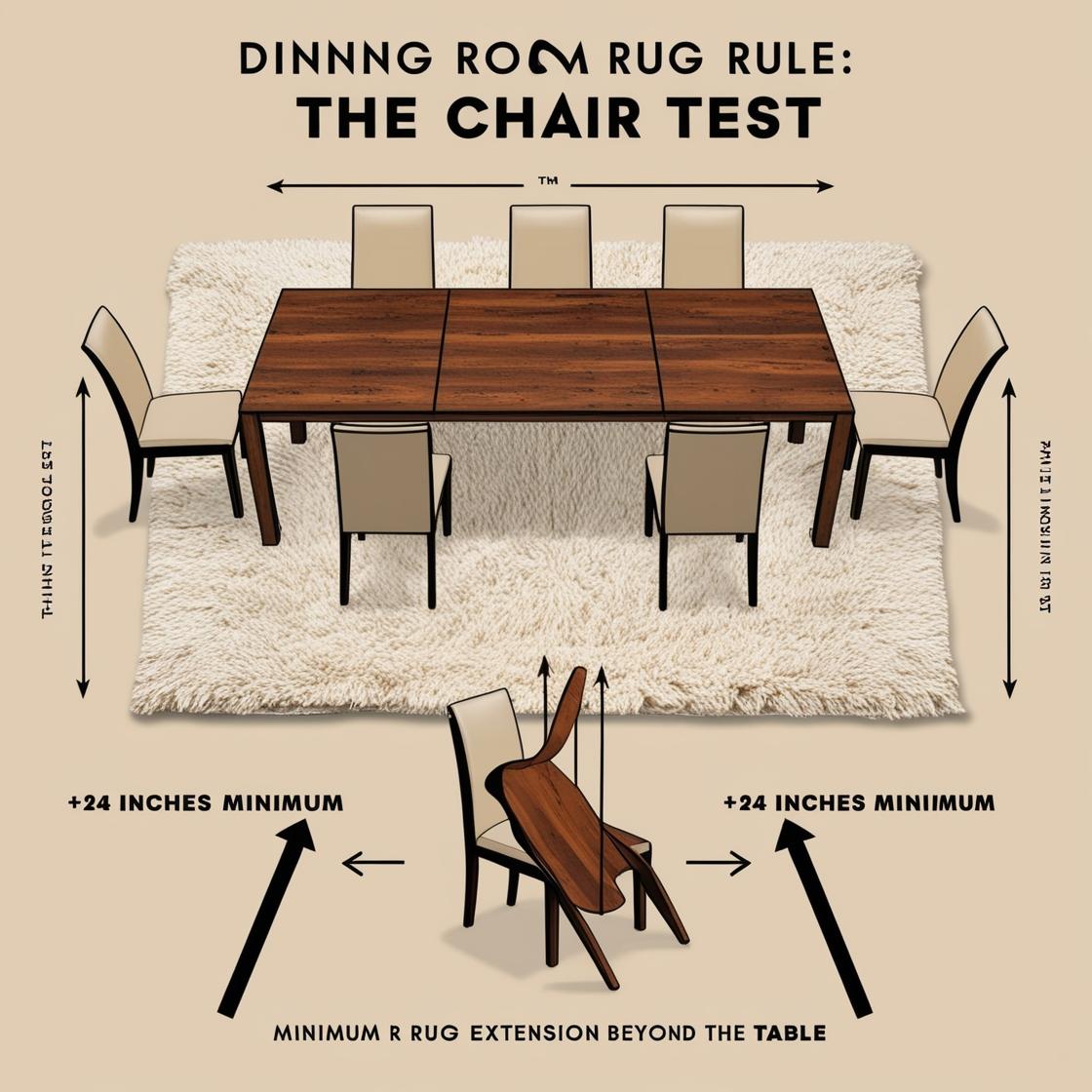
Rug Size & Placement Cheat Sheet by Room
To simplify, here's a quick reference:
| Room Type | Common Layout Goal | Key Placement Rule | Typical Standard Sizes (ft) | Pro Tip |
|---|---|---|---|---|
| Living Room | Anchor seating area, connect furniture | Front legs of major furniture on rug; OR all furniture legs on rug | 5x8 (small), 8x10, 9x12, 10x14 (large) | Leave 12-18" border from walls (up to 24" in large rooms); Tape outline first! |
| Dining Room | Fit table & chairs when pulled out | Rug extends 24-30" beyond table edge on all sides | 8x10, 9x12 (rectangular); 8' or 10' round | Match rug shape to table shape (optional); Ensure chairs don't catch edge. Size for table when fully extended. |
| Bedroom | Soft landing, define sleeping zone | Rug under bottom 2/3 of bed extending beyond sides; OR runners beside bed; OR entire bed + nightstands on rug | 8x10 (Queen), 9x12 (King), Runners (e.g., 2.5x7) | Ensure rug extends past nightstands OR stops before them consistently. Aim for 18-24" rug exposure on sides/foot. |
| Hallway/Entry | Define path, add warmth/color | Leave 4-6" floor border on sides; Don't obstruct doors or main walkways | 2x8, 3x10, Custom runners | Width is key for balance; Consider durability for high traffic. |
Avoid These Common Rug Size Mistakes!
Learning from others is key. Here are the top pitfalls seen constantly in online forums and design discussions:
Mistake 1: The Rug is Too Small (The Biggest Offender!)
This is, by far, the most frequent regret and design faux pas.
- Why it Looks Wrong: Furniture looks like it's floating disconnectedly; the room feels fragmented and smaller than it is. Commenters often describe it as looking like a "bath mat," "postage stamp," or "baby blanket" – clearly out of scale.
- Real Example: A user shared mockups comparing a 5x7 and 8x10 between two sofas. The 5x7 was widely criticized as looking like a "bath mat" because it failed to connect the furniture visually.
- The Fix: When in doubt, size UP! Layering a small rug over a larger base is also a great, stylish solution.
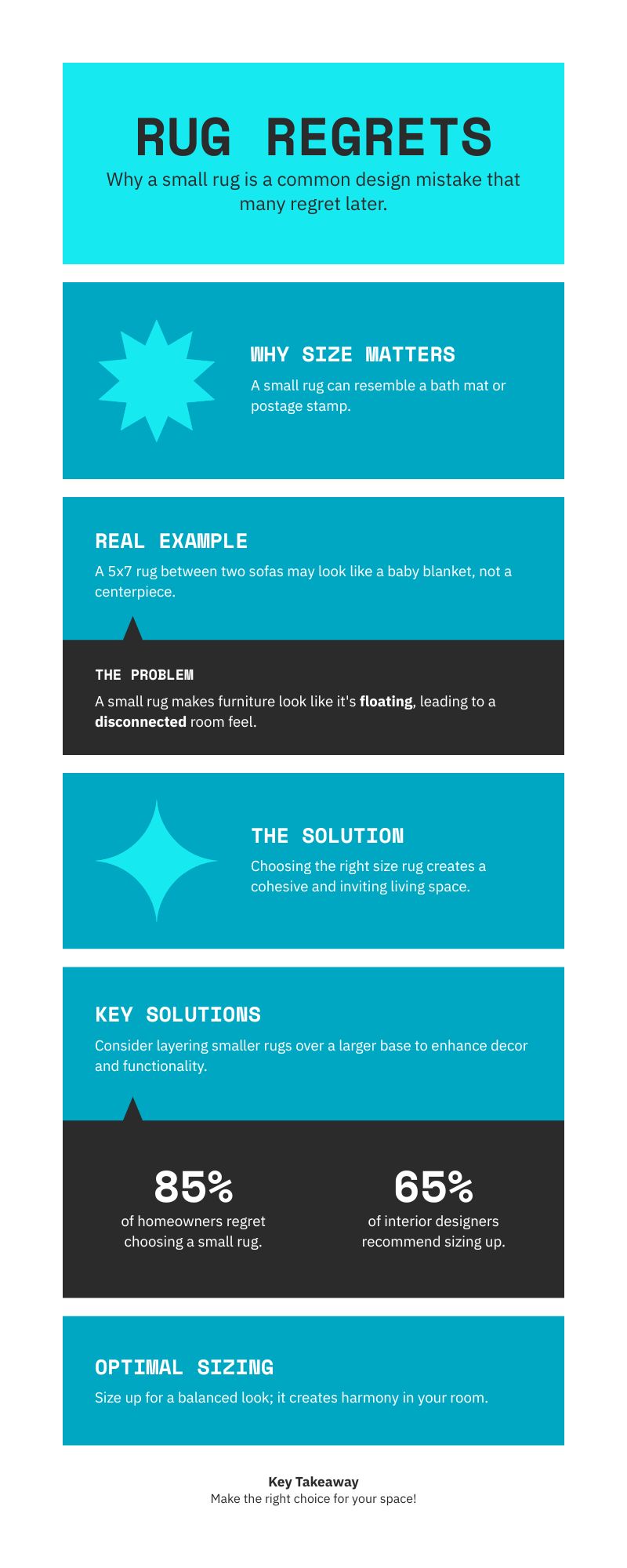
Mistake 2: The Rug is Too Big (Less Common, Still Possible)
Yes, a rug can be too large for the room, although this is less common than going too small.
- Why it Looks Wrong: It visually overwhelms the room, ironically making it feel cramped or crowded. It might leave too little floor visible around the edges, resembling ill-fitting wall-to-wall carpet , cover necessary floor vents , or create tripping hazards by extending too far into walkways.
- Real Example: A user received a dining rug slightly larger than ordered (almost 10x13 instead of 9x12). While functional for chair clearance, they initially felt it was too big because it left very little floor border visible.
- The Fix: Ensure adequate floor borders (generally 6-18 inches). Consider tucking excess rug under furniture like sofas or beds if appropriate. Measure carefully and use tape!
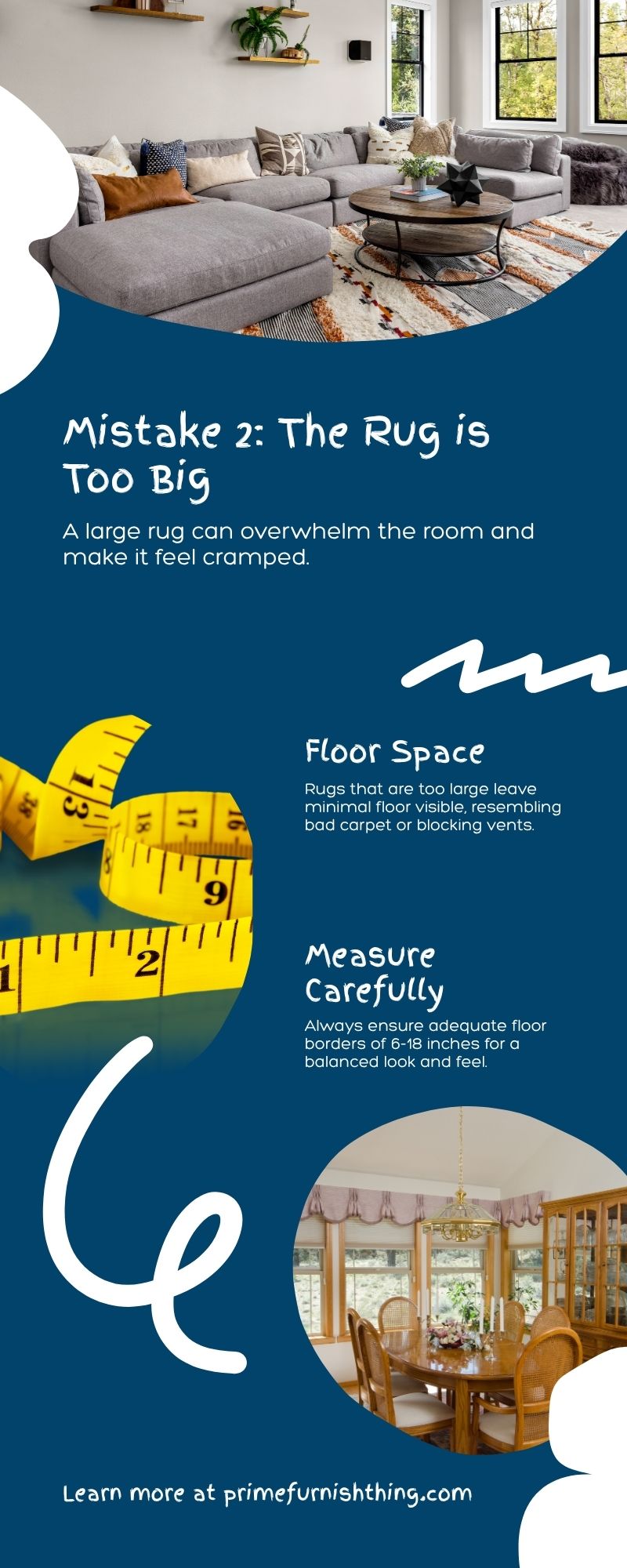
Mistake 3: Dining Chairs Catching on the Edge
This functional failure is frustrating in daily use and can damage your floors.
- Why it's Wrong: Chairs get stuck when pulled out, disrupting meals and potentially scratching the floor finish.
- The Fix: Follow the "chair test" rule strictly! Measure for at least 24 inches (preferably 24-30 inches) of clearance on all sides of the table. Choose low-pile or flat-weave rugs for easier movement.
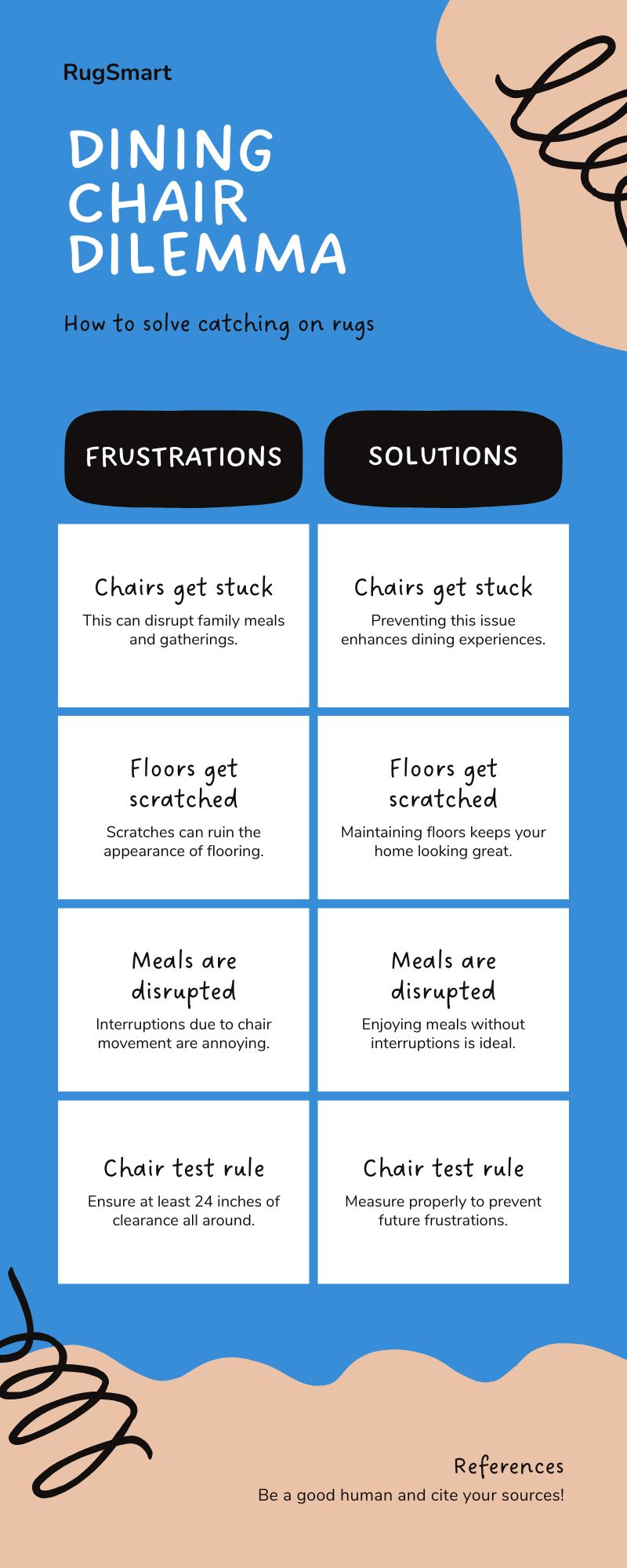
Mistake 4: Ignoring Nominal vs. Actual Size
Frustratingly, the size printed on the rug label isn't always the exact size you receive. This is known as "nominal sizing."
- Why it's Wrong: A rug that's a few inches smaller or larger than expected can throw off your careful planning, especially in tight spaces. Rug pads ordered based on the label size might then be too large or small.
- The Fix: Check if the retailer lists "actual dimensions" in the product specifications. Measure the rug yourself upon arrival. Be aware of return policies. You might need to trim a standard rug pad to fit.

Common Rug Sizing Mistakes & Quick Fixes
| Mistake | Why It Looks Wrong | Quick Fix |
|---|---|---|
| Too Small | Furniture "floats," room feels disconnected/small, looks like a "bath mat" | Size up! Layer the small rug over a larger base rug. Use painter's tape to visualize first. |
| Too Big | Overwhelms room, looks like carpet, covers vents, tripping hazard | Tuck excess under furniture. Ensure 6-18" floor border. Check walkways. |
| Dining Chairs Catch | Annoying, hard to move chairs, scratches floor | Measure table + min. 24" clearance on all sides. Choose larger rug or low-pile/flat-weave. |
| Awkward Furniture Legs | Looks unintentional (e.g., only back legs on, inconsistent placement) | Be consistent: front legs on, all legs on, etc.. Reposition rug relative to furniture. |
| Wrong Orientation | Fights room proportions, looks odd with layout | Rotate rug 90 degrees. Align with room's longest dimension or main seating. |
| Size Label Inaccurate | Rug doesn't fit space, rug pad wrong size | Check "actual dimensions" if listed. Measure upon arrival. Check return policy. Trim rug pad if needed. |

Other Considerations: Pile Height & Rug Pads
Pile Height:
Rug Pads:
Pre-Purchase Rug Size Checklist (Your Actionable Tool!)
To help you feel confident, use this step-by-step checklist before you buy:
- Measure your room's length and width.
- Measure your primary furniture grouping area (e.g., living room seating, dining table + chairs fully extended).
- Identify your room type (Living, Dining, Bedroom, Hallway, etc.).
- Review the recommended placement rule for your room type (e.g., front legs on, 24" dining clearance).
- Use painter's tape to outline the proposed rug size on your floor.
- Evaluate the taped area: Does it feel balanced? Is there ~12-24" walkway space/border from walls? Does it define the zone effectively?
- Check door clearance if the rug is near a doorway (consider pile height too!).
- Compare your taped size to standard rug sizes. Select the closest standard size (usually size up if between sizes to avoid the 'too small' mistake).
- Consider rug pile height for door clearance and furniture stability.
- Take photos of your taped outline for reference during shopping.
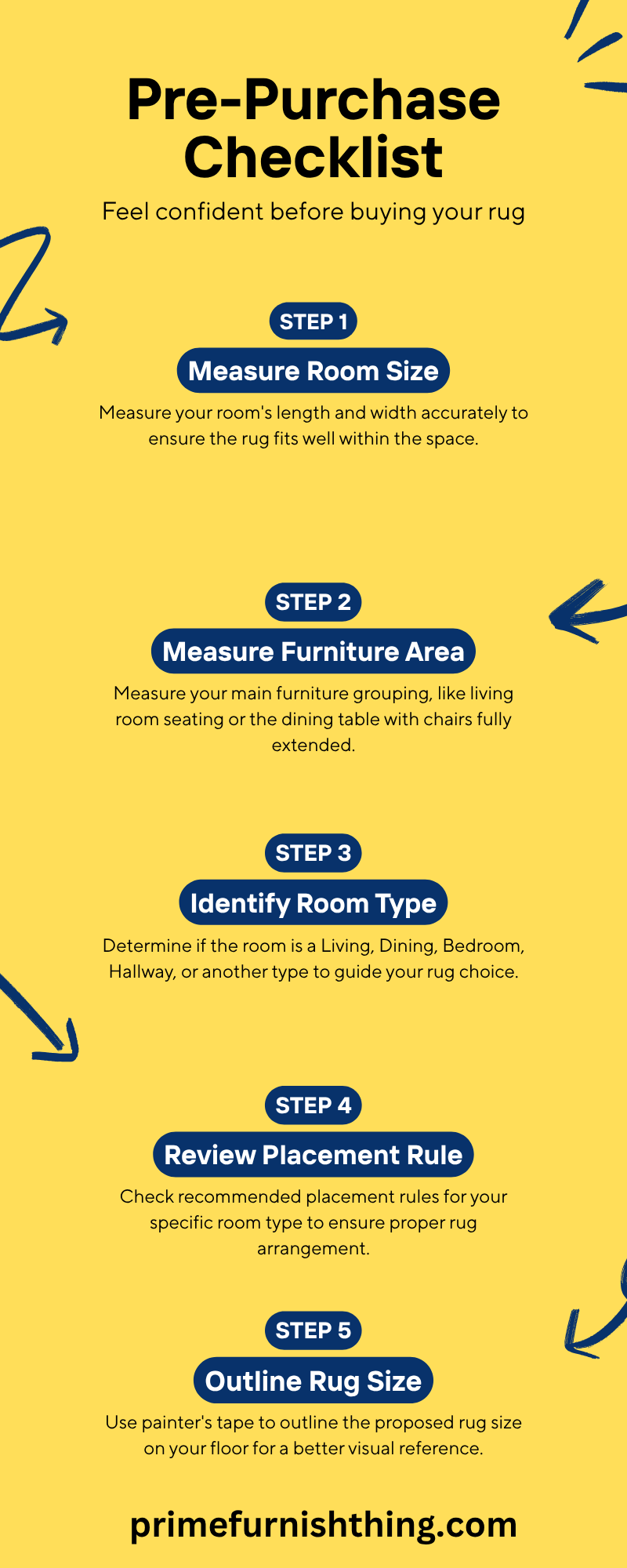
Frequently Asked Questions (FAQ)
Q: Can a rug be too big?
A: Yes. If it leaves little to no exposed floor around the edges (less than ~6 inches), covers vents, or extends into main walkways, it can overwhelm the space and look like ill-fitting carpet.
Q: What’s the best rug size for a sectional sofa?
A: Bigger is usually better! Aim for at least a 9x12 or 10x14, ensuring at least the front legs of all pieces rest on the rug. An 8x10 might work for smaller sectionals or layouts, but often looks too small.
Q: How much rug should extend beyond the bed?
A: Aim for at least 18-24 inches of rug visible on the two sides and at the foot of the bed for a comfortable landing spot.
Q: What is the 'front legs on' rule for rugs?
A: This common guideline suggests placing only the front legs of your main seating furniture (like sofas and armchairs) onto the edge of the rug. It helps anchor the furniture and connect the seating area visually without requiring a very large rug.
Q: How much space should be between a rug and the wall?
A: Generally, leave about 12 to 18 inches of bare floor between the rug's edge and the walls. In smaller rooms, a narrower border of 6 to 12 inches might look more proportional.
Q: What's the most important rule for dining room rug size?
A: The chairs must stay completely on the rug, even when pulled out for someone to sit down. Measure your table and add at least 24 inches (preferably 30-36 inches) of rug clearance on all sides.
Q: Is it okay if my rug's actual size is slightly different from the label?
A: Yes, this is common. Rugs often have "nominal sizing," meaning the actual dimensions might vary slightly (e.g., a few inches) from the standard size listed on the label (like 8'x10'). It's good practice to check for "actual dimensions" if provided by the retailer or measure the rug upon arrival, especially if a precise fit is needed.
Q: Can I layer rugs if my favorite rug is too small?
A: Absolutely! Layering is a popular solution. Place a larger, appropriately sized neutral rug (like jute or sisal) as a base, and then layer your smaller, more decorative rug on top. This achieves the right scale and adds texture.
Q: Should my living room rug be wider than my sofa?
A: Yes, ideally. The rug should extend beyond the ends of your sofa, typically by at least 6 to 10 inches on each side. A rug that is narrower than or the same width as the sofa can make the seating area look unbalanced.
Conclusion: Choose Your Rug Size with Confidence!
Choosing the right rug size doesn't need to cause decorating dread. By understanding the core principles, learning from common experiences, and using practical tools like measuring and visualizing with tape, you can make an informed choice. Remember these key takeaways:
- Anchor Your Furniture: Use the rug to visually connect your main pieces (the "front legs on" rule is usually a safe bet for living rooms).
- Respect Proportions: Leave an appropriate border of bare floor showing around the rug.
- Measure & Visualize: Don't skip measuring your room, furniture, and using painter's tape to see the size in situ! This is your best defense against mistakes.
- Know Room-Specific Rules: Dining rooms prioritize chair clearance; bedrooms prioritize comfort underfoot and bed anchoring.
- Avoid "Too Small": This is the most common and visually jarring mistake. When in doubt, sizing up slightly is often better than sizing down.
Armed with these guidelines, you can confidently select a rug that not only fits perfectly but also significantly elevates the look, feel, and functionality of your entire space, transforming it into a cozier, more defined, and beautifully pulled-together home.
Ready to find your perfect rug? Download our free printable Pre-Purchase Rug Size Checklist and start shopping confidently!


